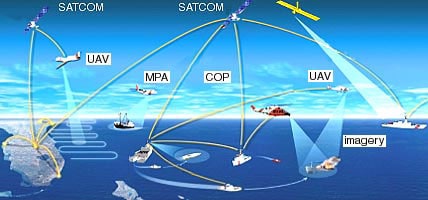 The Deputy Secretary of Transportation, Michael P. Jackson, joined by U. S. Coast Guard Commandant Thomas H. Collins, on June 25, 2002, announced the award of an initial contract valued at $11.04 billion for a fleet of new ships and aircraft, plus improved command and control systems, to meet the service’s mission needs.
The Deputy Secretary of Transportation, Michael P. Jackson, joined by U. S. Coast Guard Commandant Thomas H. Collins, on June 25, 2002, announced the award of an initial contract valued at $11.04 billion for a fleet of new ships and aircraft, plus improved command and control systems, to meet the service’s mission needs.
The contract ICGS contract, the largest ever for the U.S. Coast Guard, was awarded to Integrated Coast Guard Systems (ICGS), a joint venture established by Lockheed Martin and Northrop-Grumman. It called for the delivery of the first ships, planes and upgrades to some existing vessels within the next five years. This was the first time the Coast Guard had bundled procurement of several types of ships, aircraft and other equipment into an integrated procurement program. The contract award was designed to be extended in five year increments up to 25 years and was designed for the acquisition of up to 91 ships, 35 fixed-wing aircraft, 34 helicopters, 76 unmanned surveillance aircraft, and the upgrade of 49 existing cutters and 93 helicopters, in addition to systems for communications, surveillance and command and control.
The vessels and aircraft included in the ICGS procurement project were selected to make up the Coast Guard’s primary multi-mission coastal and offshore fleet — larger Coast Guard cutters and aircraft which serve as the backbone of many missions including drug and illegal migrant interdiction, fisheries enforcement, pollution patrols, and homeland security patrols, boardings and inspections. Command, control and communications systems were planned not only to integrate operations of the new ships and planes, but also improve coordination of all Coast Guard operations, as well as with other Federal agencies and the Department of Defense.
ICGS had broad authority to select and manage contractors and to shape the acquisition plan to best meet the Coast Guard mission requirements. The program initially had wide political support and was seen as a model for managing a technical and complex acquisition program. However, by late 2006 problems with the program had grown. Major components were failing or stalled. Eight 123-foot patrol boats, an upgraded version of the existing 110- foot patrol boats, were found to have severe structural problems and were removed from the fleet. In addition the newly launched National Security Cutter had significant design flaws.
The Coast Guard received harsh criticism for not adequately overseeing the contract. Experience has shown that the model used allowed the contractors at times to put their interests ahead of the Coast Guard. As a result of the criticism and under pressure from Congress the Coast Guard restructured the agreement in 2007. In order to provide effective management and oversight the Coast Guard assumed the role of systems integrator for all Deepwater assets and took full responsibility for leading the management of all life cycle logistic functions. In addition the role of the American Bureau of Shipping and other third parties were expanded to increase assurance that Deepwater vessels were properly designed and constructed.
Aviation forces closely monitored and contributed to the ICGS program. The upgrading of the surveillance, communications, and control capabilities of existing aircraft was done well. The HH-65 helicopter, scheduled to be the Multi-mission Cutter Helicopter was re-engined to provide greater dependability and power, six C-130J aircraft, acquired by supplemental funding, were upgraded to fully perform the interdiction and search and rescue mission, and the first of the C-144 maritime patrol aircraft was delivered. The prototype HV-911 Eagle Eye vertical take-off and landing unmanned aerial vehicle had not met performance requirements as of early 2008 and was cancelled. The UAV/UAS program established partnerships with other evaluate current and emerging UAV/UAS technologies.
